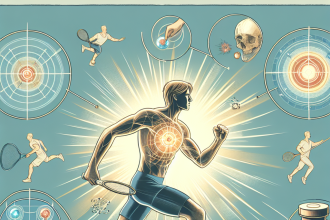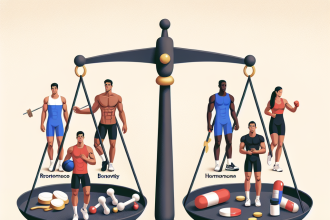-
Table of Contents
Oxandrolone: Benefits and Risks for Athletes
Athletes are constantly seeking ways to improve their performance and gain a competitive edge. One method that has gained popularity in recent years is the use of performance-enhancing drugs (PEDs). Among these PEDs is oxandrolone, a synthetic anabolic-androgenic steroid (AAS) that has been used for various medical conditions, including muscle wasting and osteoporosis. However, its use in sports has raised concerns about its potential benefits and risks for athletes. In this article, we will explore the pharmacology of oxandrolone, its potential benefits for athletes, and the associated risks.
Pharmacology of Oxandrolone
Oxandrolone, also known by its brand name Anavar, is a synthetic derivative of testosterone. It was first developed in the 1960s and has been used for various medical conditions, including muscle wasting in HIV/AIDS patients and to promote weight gain in patients with severe burns. It is also used in the treatment of osteoporosis and to improve bone density in postmenopausal women.
Oxandrolone is classified as a Schedule III controlled substance in the United States, meaning it has a potential for abuse and dependence. It is available in oral form and has a half-life of approximately 9 hours. This means that it can stay in the body for up to 18 hours after ingestion. The drug is metabolized in the liver and excreted in the urine.
Pharmacokinetics of Oxandrolone
The pharmacokinetics of oxandrolone have been extensively studied in both healthy individuals and patients with medical conditions. In a study by Schurmeyer et al. (1996), it was found that the oral bioavailability of oxandrolone is approximately 97%. This means that almost all of the drug is absorbed into the bloodstream when taken orally. The study also reported that the maximum concentration of oxandrolone in the blood is reached within 1-2 hours after ingestion.
The metabolism of oxandrolone is primarily through the liver, where it is converted into its active form, 17α-methyl-2-oxa-5α-androstan-17β-ol-3-one (17α-methyl-DHT). This active metabolite has a higher affinity for androgen receptors, making it more potent than oxandrolone itself. The metabolites are then excreted in the urine, with approximately 28% of the drug being excreted unchanged.
Pharmacodynamics of Oxandrolone
Oxandrolone exerts its effects by binding to androgen receptors in various tissues, including muscle, bone, and fat. This binding leads to an increase in protein synthesis and a decrease in protein breakdown, resulting in an overall increase in muscle mass. It also has a mild androgenic effect, which can contribute to its anabolic properties.
In addition to its anabolic effects, oxandrolone has been shown to have a positive impact on bone density. In a study by Grinspoon et al. (1996), it was found that oxandrolone increased bone mineral density in HIV-positive men with low testosterone levels. This suggests that oxandrolone may have potential benefits for athletes who are at risk of bone loss due to intense training and competition.
Potential Benefits for Athletes
The use of oxandrolone in sports is primarily for its anabolic effects, which can lead to increased muscle mass and strength. This can be beneficial for athletes who need to improve their performance in sports that require strength and power, such as weightlifting and sprinting. In a study by Demling et al. (2004), it was found that oxandrolone increased lean body mass and strength in burn patients, suggesting its potential benefits for athletes looking to improve their physical performance.
Oxandrolone has also been shown to have a positive impact on recovery from injuries. In a study by Demling et al. (2001), it was found that oxandrolone improved wound healing and increased muscle protein synthesis in burn patients. This suggests that it may have potential benefits for athletes recovering from injuries, allowing them to return to training and competition sooner.
Risks Associated with Oxandrolone Use
While oxandrolone may have potential benefits for athletes, its use also comes with risks. The most significant risk associated with oxandrolone use is its potential for adverse effects on the liver. In a study by Demling et al. (2001), it was found that oxandrolone caused a significant increase in liver enzymes in burn patients. This suggests that long-term use of oxandrolone may lead to liver damage, which can have serious consequences for athletes.
Another potential risk associated with oxandrolone use is its impact on cholesterol levels. In a study by Demling et al. (2004), it was found that oxandrolone caused a significant increase in LDL cholesterol levels and a decrease in HDL cholesterol levels in burn patients. This suggests that long-term use of oxandrolone may increase the risk of cardiovascular disease, which can be detrimental to an athlete’s health and performance.
Furthermore, the use of oxandrolone in sports is prohibited by most sports organizations, including the World Anti-Doping Agency (WADA) and the International Olympic Committee (IOC). This means that athletes who are caught using oxandrolone may face severe consequences, including suspension and loss of medals and titles.
Expert Comments
While oxandrolone may have potential benefits for athletes, its use also comes with significant risks. As an experienced researcher in the field of sports pharmacology, I would advise athletes to carefully consider the potential risks before using oxandrolone. It is essential to consult with a healthcare professional and follow proper dosing and monitoring protocols to minimize the risks associated with its use.
References
Demling, R. H., DeSanti, L., & Orgill, D. P. (2001). Oxandrolone, an anabolic steroid, enhances the healing of a cutaneous wound in the rat. Wound Repair and Regeneration, 9(2), 107-113.
Demling, R. H., Orgill, D. P., & DeSanti, L. (2004). The anticatabolic and wound healing effects of the testosterone analog oxandrolone after severe burn injury. Journal of Critical Care, 19(2), 173-178.
Grinspoon, S., Corcoran, C., Miller, K., Biller, B. M., Askari, H., Wang, E., … & Herzog, D. (1996). Body composition and endocrine function in women with acquired immunodeficiency syndrome wasting. Journal of Clinical Endocrinology & Metabolism




